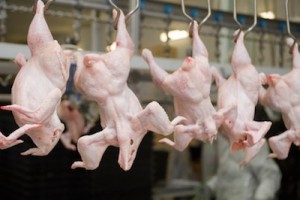The cockroaches of Foster Farms grabbed all the attention this week for giving the U.S. Department of Agriculture (USDA) the technical reason is needed to close one of three plants associated with a multi-state Salmonella outbreak that has sickened 419 people: “insanitary conditions.” The problem is that the USDA knew there were cockroaches and other insanitary conditions at the plant before the outbreak was announced months ago.
 A reasonable person might ask why producing food contaminated with antibiotic-resistant Salmonella isn’t reason enough to halt production at a poultry processing plant. The answer, in part, is that Salmonella isn’t considered an adulterant of meat (only seven kinds of E.coli are) so, it’s not illegal to produce meat or poultry with Salmonella on it. The other part of the answer, is that in 1999 the USDA shut down a meat processor because inspectors thought the high levels of Salmonella on the meat it produced, some of which was headed for the National School Lunch Program, could make people sick. The company sued the USDA for overstepping its bounds and won. Since then, the USDA has exercised extreme caution when it comes to enforcemnet action.
A reasonable person might ask why producing food contaminated with antibiotic-resistant Salmonella isn’t reason enough to halt production at a poultry processing plant. The answer, in part, is that Salmonella isn’t considered an adulterant of meat (only seven kinds of E.coli are) so, it’s not illegal to produce meat or poultry with Salmonella on it. The other part of the answer, is that in 1999 the USDA shut down a meat processor because inspectors thought the high levels of Salmonella on the meat it produced, some of which was headed for the National School Lunch Program, could make people sick. The company sued the USDA for overstepping its bounds and won. Since then, the USDA has exercised extreme caution when it comes to enforcemnet action.
What does the USDA need to find before taking action? In its January 8 letter to Ron Foster, CEO of Foster Farms, the USDA explains, “The Poultry Products Inspection Act, 21 U.S.C. 453(g)(4), states product is adulterated ‘if it has been prepared, packed, or held under insanitary conditions whereby it may have become contaminated with filth, or whereby it may have been rendered injurious to health.’ Foster Poultry Farms failed to meet the sanitary measures required by the Sanitation Performance Standards regulatory requirements, creating insanitary conditions that may result in the production of products, which may have been rendered injurious to health.”
The same letter lists four visits to the plant when cockroach activity was observed by inspectors: September 14, November 4, December 28 and January 7. The public was notified of the outbreak on October 7, three weeks after the first cockroach sighting, when the USDA issued a consumer health alert, basically announcing a multi-state outbreak, warning consumers to check packages of Foster Farms chicken for establishment numbers of three plants associated with the outbreak.
That same day, October 7, USDA sent a letter to each plant threatening to close them because of “insanitary conditions” inspectors had found at the plant in the months leading up the outbreak. That time period includes the first Foster Farms outbreak of 2013 which was not declared over by the Centers for Disease Control and Prevention (CDC) until July.
Cockroaches were not mentioned in the list of insanitary conditions USDA inspectors had documente. But there were plenty of others. One letter states, ” from January 1, 2013, (just prior to identification ofillness in early March), through September 27, 2013, FSIS personnel have documented 12 Noncompliance Records (NRs) for findings of fecal material on carcasses. Furthermore, FSIS has identified multiple noncompliances including but not limited to findings of poor sanitary dressing practices, insanitary food contact surfaces, insanitary non food contact surfaces and direct product contamination as evidenced by the documentation of a considerable number ofrecurring NRs issued to your establishment for preoperational, operational, and SPS noncompliances.”
Why are cockroaches dirty enough to cause injury in January 2014, but not September, November or December of 2013? And why are they enough to trigger a closure but all of the other findings of insanitary findings not?




